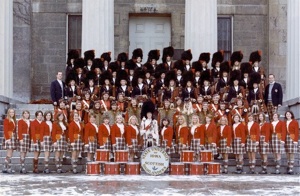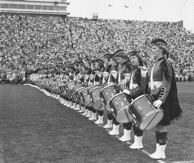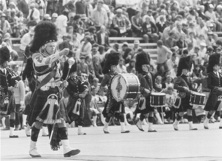
THE UNIVERSITY OF IOWA SCOTTISH HIGHLANDERS
Remembering The University Of Iowa Scottish Highlanders
Created in 1936 by Colonel George F. N. Dailey, The University of Iowa Scottish Highlanders started out as an all male band, connected to the university’s R.O.T.C. department. Introduced to the public, the enthusiasm was overwhelming as Dailey was approached by many male students who wanted to join this new and unique group. Colonel Dailey then hired William Adamson from Boston, to instruct and direct the growing band. In 1937, the Scottish Highlanders first began to perform at University of Iowa Hawkeye football games. The band continued to grow in numbers and popularity until the early 1940’s, when World War Two depleted the male students on campus. In 1943, Adamson made the decision to open membership to female students. Hundreds applied, and soon, the University of Iowa Scottish Highlanders became the largest all female bagpipe band in the world.
In the decades that followed, the Highlanders became extremely popular and world famous. Besides performing at halftime at Iowa Hawkeye football games (and one Big Ten away game each season), the Scottish Highlanders performed before millions around the world, both in person and on television. Noteworthy appearances include The Tonight Show, The Ed Sullivan Show, Macy’s Thanksgiving Day Parade, the New York World’s Fair, Chicago’s St. Patrick’s Day Parade, two Rose Bowls, and Disneyland plus Disney World. The Highlanders have been ambassadors for their university, the state of Iowa, and the United States, during seven world tours, starting in 1952, where they were greeted by large, appreciative crowds in Scotland, England, France, and across Europe.
Some of the many celebrities who were entertained by the Highlanders (and who have autographed Highlander drum heads) include Presidents Dwight Eisenhower, John Kennedy, Richard Nixon, and entertainers Bob Hope, Ed Sullivan, Art Linkletter, Johnny Carson, Mary Pickford, and many others.
The band, comprised of pipers, drummers, and dancers, were often complimented on their musical ability as well as their showmanship. The Highlanders wore authentic Scottish attire, part of which included real leopard skins and ostrich feather bonnets.
In 1972, membership was open to both male and female students. In the Spring of 1981, the University of Iowa eliminated the Highlander’s budget, and the glory days were gone.
For those who belonged to this unique band, and for those millions who were entertained by them, the University of Iowa Scottish Highlanders remain a cherished memory forever.





